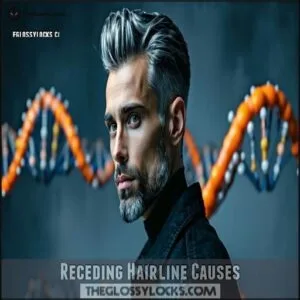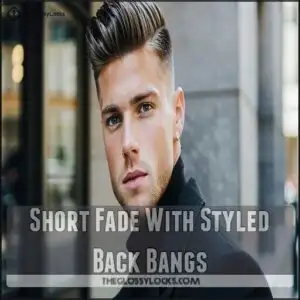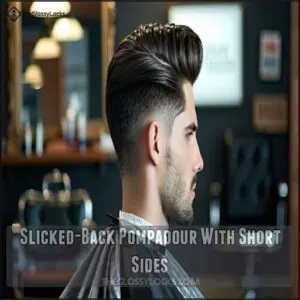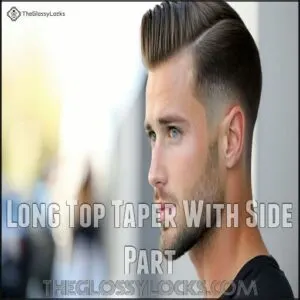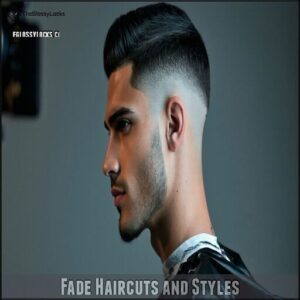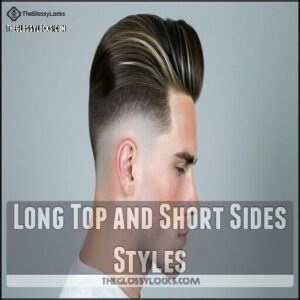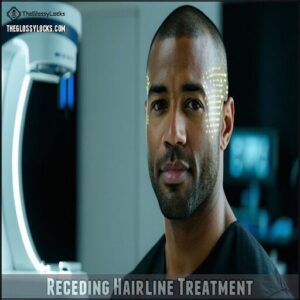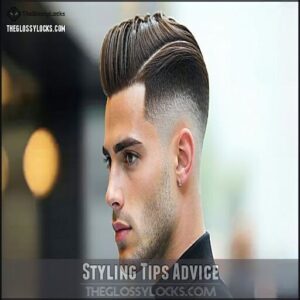This site is supported by our readers. We may earn a commission, at no cost to you, if you purchase through links.
 You can rock your receding hairline with the right cut.
You can rock your receding hairline with the right cut.
The best hairstyles for receding hairline include the buzz cut, which keeps things simple, or a textured crop that adds volume where you need it.
Try a high fade with longer top to draw attention upward, or embrace the classic side part that works like a charm for many men.
Short styles with forward texture can camouflage thinning areas, while longer styles with light layering create an illusion of fullness.
Remember, confidence is your best accessory—these styles don’t just hide your hairline, they highlight your best features.
Table Of Contents
- Key Takeaways
- Receding Hairline Causes
- Best Hairstyles Options
- Hair Growth Strategies
- Popular Haircuts Styles
- Receding Hairline Treatment
- Styling Tips Advice
- Frequently Asked Questions (FAQs)
- What are the Best Hairstyles for men with receding hairlines?
- What are some long haircuts that work well with a receding hairline?
- How to style a receding hairline?
- What hairstyle is good for concealing a receding hairline?
- What hairstyles flatter a receding hairline?
- What can you add to a slick back hairstyle for a receding hairline?
- What hairstyles work for receding hairline?
- What is a receding hairstyle?
- How do I choose the right haircut for a receding hairline?
- What hairstyle suits a man with a receding hairline?
- Conclusion
Key Takeaways
- Don’t hide your receding hairline—styles like a buzz cut, textured crop, or slicked-back fade can enhance your look and confidence.
- Use fades or side parts to balance proportions and shift attention away from thinning areas.
- Healthy habits like a balanced diet, scalp massages, and proper product use can improve hair and scalp health.
- Embracing your style, whether through trendy cuts or a clean-shaven look, makes confidence your best accessory.
Receding Hairline Causes
Your receding hairline likely stems from genetics, hormones, stress, or medical factors, with male pattern baldness affecting about 50% of men by age 50.
You can still rock amazing hairstyles that work with your hairline, and choosing the right cut can actually enhance your overall look, which can help you rock amazing hairstyles.
Androgenetic Alopecia
Nearly half of all men face androgenetic alopecia, the most common cause of a receding hairline.
It occurs when your hair follicles are sensitive to DHT, a hormone that shrinks them over time.
- Hair follicle miniaturization causes gradual thinning
- Typically begins at the temples, creating an "M" shape
- Progression stages vary, with some men balding rapidly
- Treatment efficacy depends on early intervention
Don’t worry—understanding male pattern balding is your first step toward managing it effectively. A key sign is hair loss at temples.
Hereditary Factors
Your family tree plays a major role in your receding hairline.
If your dad, grandpa, or uncles have male pattern balding, you’ve likely inherited those baldness genes.
Genetic predisposition accounts for about 80% of hair loss cases, with specific inherited traits determining when your hairline starts to retreat.
These ancestral patterns of androgenetic alopecia typically follow predictable paths based on your hairline genetics.
Stress and Poor Diet
Your daily stress levels and eating habits play a significant role in hairline recession.
Stress impact on your scalp health manifests through:
- Increased cortisol triggering premature hair loss
- Poor nutrient absorption affecting hair follicle strength
- Disrupted sleep patterns accelerating hair thinning
- Stress-induced habits like scalp scratching damaging follicles
Diet deficiencies, particularly in proteins and vitamins, can worsen the situation, and lifestyle changes incorporating stress reduction and a healthy diet are essential defense mechanisms to combat hair loss, promoting overall scalp health with healthy diet.
Medical Conditions and Medication
While diet and stress play their part, your medicine cabinet might be plotting against your hairline too.
Various medical conditions and medications can trigger unexpected hair loss.
| Condition | Treatment Option |
|---|---|
| Thyroid Issues | Hormone therapy |
| Autoimmune Diseases | Immunosuppressants |
| Scalp Infections | Antifungal medications |
| Anemia Impact | Iron supplements |
Medications like blood pressure drugs and antidepressants can cause hair loss as a side effect.
Solutions range from Minoxidil (Rogaine) to hair transplants, depending on severity.
Best Hairstyles Options
You don’t need to hide your receding hairline when you can style it with these trendy, confidence-boosting options that work with your natural hairline.
From high comb over fades to textured tops with short sides, these modern cuts will transform your look while working with, not against, your current hair pattern, using trendy styles.
High Comb Over Fade
After understanding the causes of hair recession, you’ll want solutions that look intentional, not desperate.
The High Comb Over Fade offers a stylish fix for your receding hairline. By combing longer hair over a side part, you’ll conceal thinning temples.
This style works best with decent hair thickness and requires quality styling products.
Adjust the fade height based on your preference. Maintenance frequency? Just 2-3 weeks between cuts, which is a relatively low maintenance schedule.
Short Fade With Styled Back Bangs
Looking for a stylish way to tackle a receding hairline? The short fade with styled back bangs is your answer.
This cut features seamlessly faded sides while longer bangs are styled over and back to cover receding zones. It’s ideal for most hair types, especially straight to wavy textures.
For best results, use a medium-hold pomade and blow-dry your bangs backward for added volume. Many prefer this styling product for its reliable hold.
Slicked-Back Pompadour With Short Sides
While styled back bangs work well, the Slicked-Back Pompadour With Short Sides offers fullness where you need it most.
This classic mens hairstyle creates volume in the center that naturally draws attention away from receding areas.
Your hair texture determines which Pompadour Variations will work best – thicker hair holds better, but modern Styling Products can help finer hair achieve similar results.
Pomade offers definition and control for this style. Pair with trimmed sides for a balanced look that complements most face shapes.
Mid Drop Fade With Long, Tousled Top
Why not try a Mid Drop Fade with Long, Tousled Top? This trendy receding hairline style features an angled fade that cleverly disguises your hairline while the tousled top adds volume where you need it most.
Modern fade variations like this work perfectly for men who want a low-maintenance yet stylish look.
Simply apply texturizing products to create that effortlessly messy finish that’s still completely put-together.
Long Top Taper With Side Part
The Long Top Taper with Side Part minimizes the appearance of your receding hairline by strategically placing the part. This classic style creates visual balance while highlighting areas where your hair remains full.
The side part draws attention away from thinning temples and creates a distinguished look that works for most face shapes.
- Hair texture matters—fine hair needs lightweight products, while coarser hair benefits from stronger hold formulas
- Part placement should complement your natural hairline, not fight against it
- Taper length can be adjusted according to how much recession you’re working with, considering your natural hairline and hair texture.
Hair Growth Strategies
You’ll find several effective strategies to boost hair growth while rocking your chosen hairstyle, from improving your diet to giving your scalp some TLC.
While styling choices can mask a receding hairline, these growth techniques work alongside your haircut to address the root causes, and provide a way to boost hair growth.
Healthy Diet and Nutrition
While you’ve found the perfect hairstyle for your receding hairline, your diet plays a major role in hair health. What you eat directly impacts your hair follicles and growth cycles.
| Hair-Healthy Food | Benefits for Hair Growth |
|---|---|
| Protein-Rich Foods | Builds hair cells, prevents excessive shedding |
| Omega-3 Sources | Reduces scalp inflammation, increases density |
| Antioxidant Foods | Protects hair cells from free radical damage |
Your protein intake should be about 0.8g per kg of body weight to support hair regrowth. This is crucial for maintaining healthy hair and ensuring your hair cells are well-supported.
Scalp Health and Massage
Beyond eating right, your scalp deserves special attention too. A healthy scalp creates the foundation for stronger hair growth, especially when fighting against receding hairlines.
You can improve circulation to hair follicles through regular massages, which may help slow hair loss. Also consider a scalp massage tool for enhanced benefits.
- Use fingertips to apply gentle pressure in circular motions for 5 minutes daily
- Try a silicone scalp massager to enhance product absorption
- Apply natural oils like rosemary or peppermint before massaging to boost circulation
- Exfoliate weekly to remove dandruff and buildup that clogs follicles
- Rinse with cool water after washing to close cuticles and protect scalp health
Stress Management and Relaxation
Stress triggers hair loss, creating a frustrating cycle that worsens your hairline recession.
Incorporate stress reduction techniques like meditation, deep breathing, or yoga into your daily routine.
Mindfulness practices can substantially impact your hair’s health by regulating hormones that affect growth, and even 10 minutes of relaxation daily improves mental wellbeing and may slow hair thinning.
Holistic wellness approaches support healthier hair while enhancing your overall quality of life.
Professional Consultation and Advice
When dealing with a receding hairline, don’t underestimate the value of professional consultation.
A hair loss practitioner can provide Expert Hair Analysis and create a Personalized Style Guide suited to your specific needs.
Dermatology specialists offer Treatment Plan Options while cosmetology experts suggest appropriate hairstyles.
These professionals provide Confidence Building Support and Long-Term Haircare advice, including potential hair transplant possibilities.
Regular consultations guarantee you’re making informed decisions about your hair’s future.
Popular Haircuts Styles
You’ll find plenty of stylish options to mask a receding hairline, from classic high fades that blend seamlessly into your natural hairline to textured tops that create the illusion of fullness.
The right cut, whether it’s a slicked-back pompadour or a tousled crop with short sides, can transform your look and boost your confidence without drawing attention to thinning areas, making it a great way to achieve a fullness of hair.
Fade Haircuts and Styles
Fade haircuts are your secret weapon against a receding hairline.
Tapered sides draw attention away from temple areas, while various fade variations offer flexibility.
A high skin fade blends seamlessly with your natural hairline, creating a clean look.
Undercut styles paired with longer tops create dimension, making thinning less noticeable.
The best part is that fade maintenance is minimal – just schedule regular trims every 2-3 weeks to keep those receding hairline styles looking sharp.
Textured and Spiked Styles
Textured and spiked styles create visual interest that draws attention away from your receding hairline.
These edgy looks add volume where you need it most, creating an illusion of fullness.
- Modern mohawk styles offer dramatic height with tapered sides
- Textured crop haircuts provide versatile, low-maintenance options
- Feathered front styles effectively conceal temple recession
- Spiked hair with volumizing products adds dimension and fullness
- Edgy textured crests work well with mens hairstyles for thinning areas, adding visual interest and creating a stylish look with edgy touches.
Long Top and Short Sides Styles
Long hair on top with clipped sides creates a striking contrast that masks hair loss beautifully.
You’ll want to experiment with undercut variations that complement your face shape pairing.
| Style Element | Best For |
|---|---|
| High Undercut | Square Faces |
| Mid Fade | Round Faces |
| Low Fade | Oval Faces |
| Tapered Sides | Heart Shaped |
| Disconnected | Diamond Shaped |
Top length options range from 3-6 inches. Use lightweight styling products to maintain volume while blending your mens haircuts naturally with fade progressions that soften your receding hairline, creating a more natural look.
Slicked Back and Pompadour Styles
When style meets strategy, pompadour variations become your receding hairline’s best friend.
These hairstyles for balding men work wonders by focusing attention upward. Apply strong styling products to create sleek slicked back textures that hide men’s hair loss.
Master volume techniques by blow-drying hair backwards. Modern comb over pompadours provide extra coverage at temples.
Short slicked back versions with facial hair pairing create a balanced, confident appearance.
Receding Hairline Treatment
If hairstyles aren’t enough, you’ve got plenty of treatment options to fight back against your receding hairline.
From FDA-approved medications and hair transplants to modern laser therapies and temporary fixes like wigs, you can choose a solution that fits your budget, lifestyle, and comfort level, with options ranging from modern laser therapies.
Hair Growth Products and Medication
Your doctor’s prescription can reveal effective solutions for receding hairlines through FDA-approved medications.
Minoxidil strengthens existing hair follicles, delivering visible results within months. Finasteride blocks DHT, the hormone responsible for hair loss, achieving impressive recovery rates.
Both treatments require patience, as hair growth products need consistent application. Saw palmetto acts as a natural DHT blocker, offering another avenue for treatment.
Side effects are typically mild, and emerging treatments continue to improve success rates. Consult your dermatologist to explore suitable options.
Hair Transplants and Surgery
Hair transplants offer lasting hairline surgical solutions for those ready to invest in their appearance.
Popular surgical techniques include FUE and FUT procedures, with transplant costs ranging from $4,000-$15,000 depending on coverage needed.
The recovery process takes about two weeks, and while potential risks like scarring exist, expected results can be remarkably natural when performed by experienced surgeons.
Hair transplant considerations should focus on finding qualified professionals.
Laser Therapy and Scalp Pigmentation
If surgery isn’t your thing, you’ve got modern alternatives worth checking out.
Laser therapy stimulates follicles by boosting blood flow and nutrients to your scalp, while scalp micro pigmentation creates the appearance of fuller hair through precision tattooing.
- Non-invasive procedures with minimal downtime
- Long-lasting results with proper maintenance
- Combination therapies enhance overall effectiveness
- Treatment safety backed by professional expertise
Cost varies, but both options offer impressive results without going under the knife, providing a long-lasting solution with proper maintenance.
Hairpieces and Wigs
While laser treatments offer high-tech solutions, many men find that hairpieces and wigs provide immediate, non-invasive hairline coverage.
Today’s options look incredibly natural and offer versatility for any style preference. A good place to start is by browsing men’s hairpiece options.
| Wig Materials | Hairpiece Attachment |
|---|---|
| Human Hair | Tape Adhesive |
| Synthetic | Clip-In |
| Mixed Blend | Liquid Bonding |
| Lace Front | Vacuum Fit |
You’ll want to evaluate custom wigs for the most realistic look. Proper wig maintenance extends lifespan, while multiple styling options let you change your look whenever you want.
Styling Tips Advice
You’ll find the right hairstyle for your receding hairline by working with your natural hair texture, face shape, and maintenance preferences.
The best styling approach uses the right products, tools, and techniques to create volume where needed, while avoiding heat damage that can worsen thinning.
Choosing The Right Hairstyle
While treatments offer solutions, finding the right hairstyle for your receding hairline boils down to what suits you personally.
Your face shape, hair texture, and lifestyle needs should guide your choice.
Don’t just follow trends—pick a style that matches your maintenance level and personal style. Texturizing sprays add volume, making them a great option for styling.
- Round faces benefit from height on top like quiffs or pompadours
- Square faces look great with textured crops or side parts
- Oval faces can rock almost any receding hairline haircut
- Fine hair works better with shorter styles that create volume
Fine hair and oval faces have more versatility in hairstyles, but ultimately, the key is finding a style that complements your features and is easy to maintain, considering your lifestyle needs.
Minimizing Heat Styling and Damage
Excessive heat styling can accelerate hair loss when you’re already dealing with a receding hairline.
Always apply Heat Protectants before using styling tools, and switch to Low Heat Styling whenever possible.
Try Air Drying Techniques and Gentle Towel Drying to minimize breakage.
Hydrating Products help strengthen thinning hair styles, while reducing how often you use hot tools can prevent further damage to your hairline management routine.
Embracing Baldness and Confidence
Going bald? It’s time to explore the self-acceptance journey.
Embrace the journey—bald is bold, confident, and undeniably powerful. Shaving it all unlocks a polished, fearless look.
Many men find that embracing baldness positivity becomes their most confident appearance. A clean shave often looks more polished than fighting a receding hairline.
Remember, Jason Statham and Dwayne Johnson built careers on their baldness. Overcoming insecurities starts with owning your look.
Balding gracefully styles include buzz cuts or completely shaved heads—both requiring minimal maintenance while maximizing confidence.
Regular Exercise and Healthy Lifestyle
In addition to picking the right haircut, your lifestyle plays a vital role in managing hair loss.
Regular exercise boosts circulation to your scalp, potentially slowing your receding hairline progression.
Make smart diet choices rich in proteins and vitamins.
Prioritize stress reduction techniques and quality sleep, as both impact hair growth.
Don’t overlook hydration importance—drinking enough water helps maintain healthy follicles for better hairline treatments.
Frequently Asked Questions (FAQs)
What are the Best Hairstyles for men with receding hairlines?
Think you’re losing the battle with your hairline? Don’t worry!
Try a buzz cut, fade, textured crop, or comb over.
These styles can mask thinning while keeping you looking stylish and confident.
What are some long haircuts that work well with a receding hairline?
You can try brushed-back styles with longer tops, layered cuts that add volume, or side-swept looks. Slicked-back pompadours and textured forward styles also work well to camouflage receding temples.
How to style a receding hairline?
Did you know 50% of men face hairline challenges by age 50?
Style yours confidently by brushing hair forward, using matte products for volume, or embracing fades.
Keep it sharp, and you’ll look polished!
What hairstyle is good for concealing a receding hairline?
A short textured crop works wonders for hiding a receding hairline.
The layered front adds fullness, while short sides keep it sharp.
It’s easy to style and makes your hairline blend naturally.
What hairstyles flatter a receding hairline?
A receding hairline isn’t the end of style.
Opt for a buzz cut, slicked-back fade, or messy fringe.
These cuts redirect attention, add volume, and create balance, letting you confidently own your look.
What can you add to a slick back hairstyle for a receding hairline?
Boost a slick hairstyle by adding a mid or high fade.
It sharpens the look and shifts attention from your hairline.
Pair it with a beard for balance or subtle texture for depth.
What hairstyles work for receding hairline?
You might think it’s hard to find stylish options, but plenty work!
Try a buzz cut, slicked-back look, or textured crop.
These styles balance simplicity with sharpness, making the most of what you’ve got.
What is a receding hairstyle?
A receding hairstyle complements a thinning hairline by working with the hair’s natural shape.
It focuses on blending or concealing recession with trendy cuts like fades, textured styles, or slicked looks, offering confidence and flair.
How do I choose the right haircut for a receding hairline?
Around 42% of men experience noticeable hairline changes by age
To pick the perfect haircut, focus on styles like buzz cuts or fades that balance proportions.
Highlight your features while minimizing attention to thinning areas, using styles that create a balanced look, such as fades.
What hairstyle suits a man with a receding hairline?
A clean shave makes a bold statement, while a crew cut or an ivy league offers a timeless touch.
High fades and textured crops keep things stylish, drawing attention away from thinning areas effortlessly.
Conclusion
Why settle for a style that doesn’t make you feel your best?
The right cut can turn a receding hairline into a trendy statement. From a buzz cut to a high fade with texture, these hairstyles shape and elevate your look.
Pair them with healthy habits and confidence, and you’re golden.
The best hairstyles for a receding hairline aren’t just about hiding thinning areas—they’re about highlighting what makes you, you, and helping you own it.
Find your look and own it!

